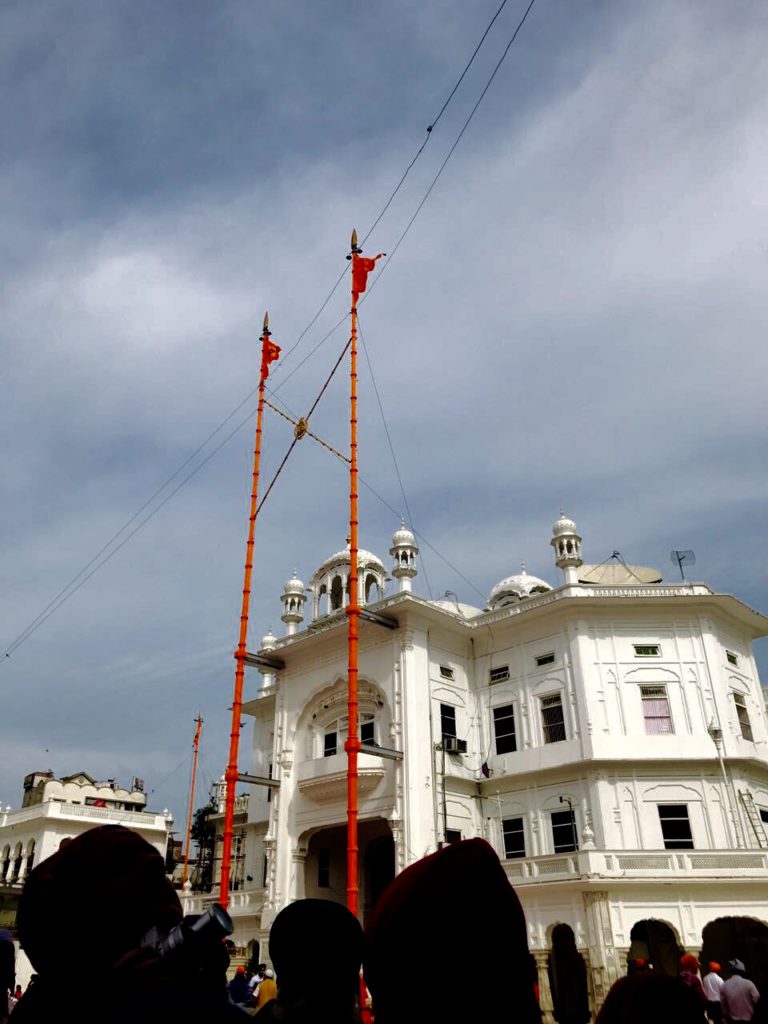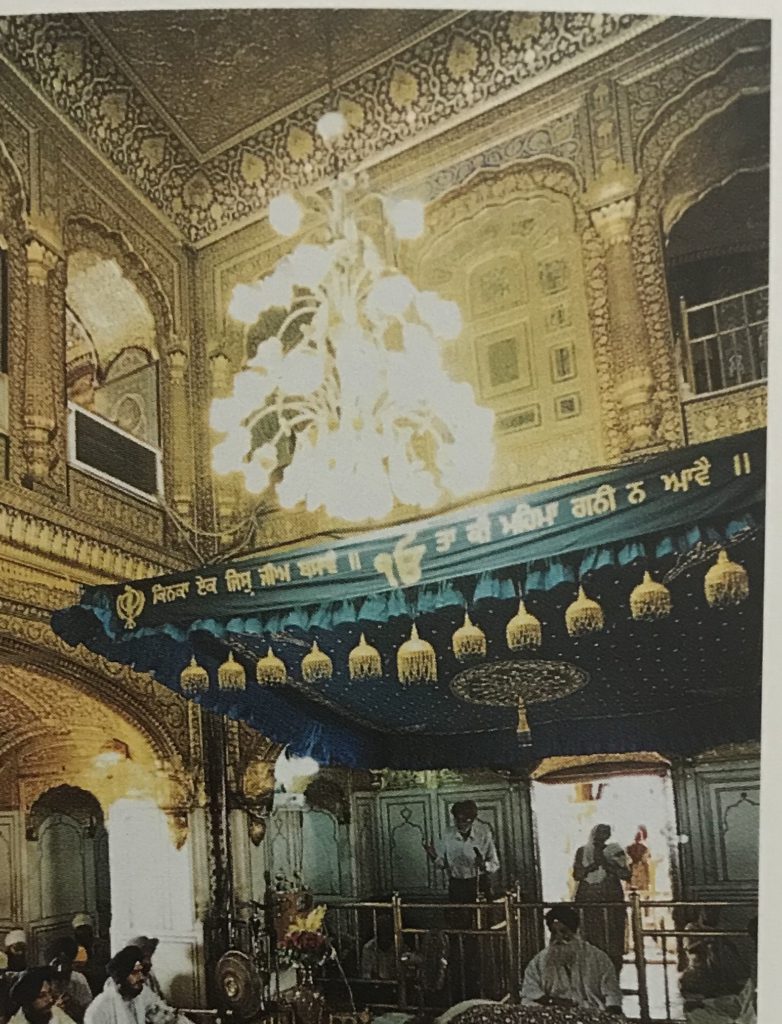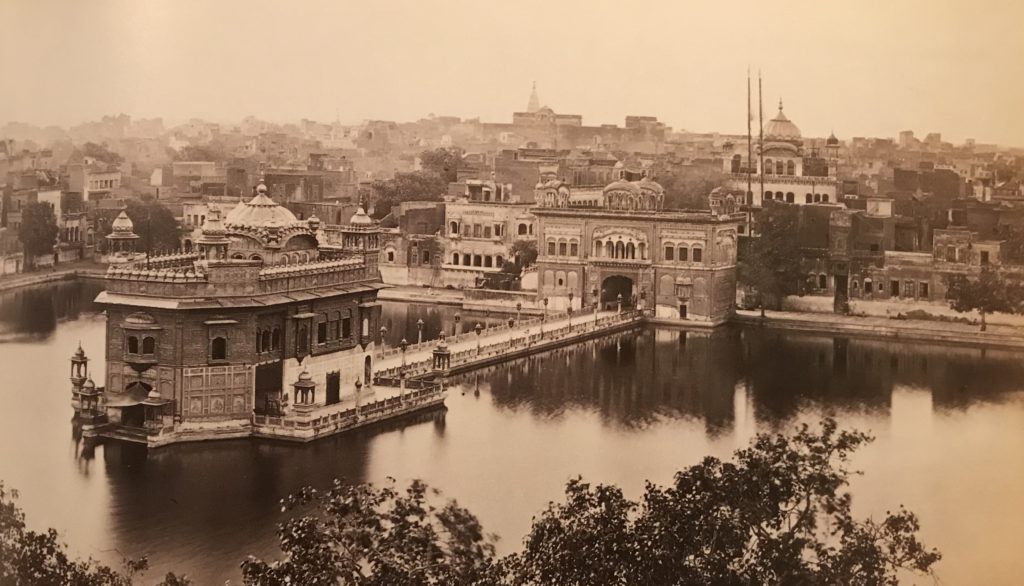Whether the medieval Gurudwara in Amritsar or the postmodern Gurudwara in metropolitan city, people seem to feel similarly when experiencing the space of a Gurudwara. For some, it is a meditative experience in the peace and quiet of the Gurudwara, for others, a feeling of belonging (being among people from all walks of life), and some even feel it to be a ‘different world’ altogether.
What then is the symbolic essence of a Gurudwara?
Is it the comfortable escape from the hustle-bustle of the world as one sits in a quiet corner to listen to Gurbani or is it in experiencing the sense of community as we all sit down together for langar?
Perhaps it is both – a place for mindful contemplation as well as meaningful action. As one moves through the space of any gurudwara, recognizing the various symbols and insignia of faith, one absorbs a reaffirmation of the ideologies and principles of Sikhi. At every point there exists a feeling of distinctness followed by a sense of belonging and responsibility, may it be upon approaching a Gurudwara and seeing the Nishan Sahib (Sikh flag) fluttering or doing Sewa (service) in a packed Langar Hall.

The Banner of Faith
Among the first distinct markers or insignias of the Sikh faith is the Nishan Sahib, which one may spot from a distance irrespective of the part of the world they visit a Sikh shrine. The Nishan Sahib is constituted of various parts but the most recognisable ones are the long pole set at a vertical axis of 90 degrees with mostly, a saffron coloured triangle that flutters from the top. As one follows the Nishan Sahib from the parapet at the base to the flag high above in the sky, one is symbolically elevated to the realm beyond the earthly – a spiritual realm. The Nishan Sahib is an ensign of ‘harmony between the God factor and Shakti’ and is seen not just in Gurudwaras but also in processions and gatherings where the Sri Guru Granth Sahib is present. The relationship of the Nishaan and the Guru is symbiotic. Even the Sikh Regiment which always carried upon their head the Holy Granth would have a procession leader with the Nishaan.
Flags are generally hoisted with a sense of purpose – conveying ownership, a unique philosophy, an identity and espousing a certain ideology. Essentially the Nishan Sahib is a marker of the Khalsa (Panth – the Sikh world) and like any other flag marks distinctness and sovereignty – of mind and body. It is also an indicator of the Sikh way of life. A life of unity, a unity of the people who follow the philosophy of Sikhism. A people who imbibe the qualities of being one, and above all, of being equal in the eyes of the Almighty.

The Royalness of Faith
It is carrying this sense of conscientiousness that with a bowed head and folded hands the Sikh enters the main prayer hall of the gurdwara, only to kneel down infront of the holy Granth. The Sri Guru Granth Sahib is tended by a Granthi who intermittently waves the Chaur Sahib (a wisp traditionally made of Yak hair with a handle made of sandalwood) over it. One is instantly reminded of the Royal insignia – the canopy, wisp and palanquin as used for Kings and rulers in processions and settings.
The Royal insignia works as a reiteration and affirmation of the fact that the Sri Guru Granth Sahib is the only true King or the ‘Sachapadshah’ for the Sikhs. It is the chosen Guru/Guide whose word is the ultimate, the only one to whom a Sikh will show obeisance. Thus in the middle of any Gurudwara one will not see a deity, images or even idols but will only hear the meditative recitation of verses from the Holy Granth.
Typically placed under the central dome of the main gurudwara building , the Sri Guru Granth Sahib is placed atop a Palki (Palanquin) typically made of a wood with a raised seat to place the Holy Granth upon. The Palki has a canopy of its own even though a larger canopy is spread above under the dome of the Gurudwara building. Placed on a stage higher than the ground, the Granth is visible to everyone in the prayer hall and sits higher than all.
The tradition goes back to Guru Arjan who compiled the holy text for his community and ceremoniously installed the first volume in the inner sanctuary of the Harmandir on 16th August 1604 (The Sikh Religion – Nikky- Guninder Kaur Singh). The Granth was carried in a brass band procession on a sandalwood palanquin while the Guru waved the wisp (Khokkar, Essays on Sikh Values). A new bed was also made on the right of the Akal Takht (Seat of the Almighty) in Harmandir Sahib, in Amritsar. The Akal Takht was built in 1609 by the Sixth Guru, Guru Hargobind Sahib to hold court where he listened to the woes of the people and served the Sikh Panth.

It is interesting to note that the stage built at Akal Takht, the ‘highest temporal seat’ which addressed the concerns of the people and gave power to the people to mete out justice (the Sarbat Khalsa met here and penalised Maharaja Ranjit Singh, a Sikh ruler) was built higher than the then Emperor’s (Jehangir’s) seat in Diwan-e-aam, Red Fort. Yet it was purposely built a fraction lower than the Harmandir Sahib, implying the order of importance, that ‘the search of spiritual grace was always higher.’ Today out of the two banners hoisted at the Akal Takht in Amritsar, one can notice the banner of the spiritual realm towards Harmandir Sahib fly higher than the one towards the Akal Takht.
The Word of Faith
In the Gurudwara one bows only to the Hukam that guides us to the truth of the essence of life in the Guru Granth Sahib. Hukam that is contemplated upon and meditated upon either individually or collectively. While it is important to listen to the word of God, it is equally important to act upon the word of God in the world one participates in. In the 15th Century, Guru Nanak Dev Ji did away with the priestly class and preached equality and oneness.
Sikhism as a religion and practice posits a community of learners who collectively exercise leadership over their affairs. In this egalitarian community of believers and learners, the ‘word of the God’ through the living Guru – The Guru Granth Sahib, holds the highest honour.
The Community of Faith
A lot of the rites of passage of the Sikhs take place around the Sri Guru Granth Sahib, in the presence of Sadh Sangat (holy congregation). Marriages, Naming a Child, Final prayer, Thanksgiving all such events are held and carried out in the presence of a congregation. The Sikhs encourage praying together for another person and they believe that the Ardas or supplication done collectively is heard by the Almighty.
The role and significance of Sangat (congregation) is of pivotal importance in Sikhi. It is valuable not just in terms of the congregation of God-oriented people, Sadh Sangat, only but is also a valuable brotherhood. Whether one sits down to prayer, sits down to eat or does sewa, the idea that everyone shares the same space, sits together and is welcome is of extreme importance in Sikhi. After praying together when the Sangat participates in sewa or sits together at the same level, irrespective of caste, class and gender, one is able to imbibe ‘humility, indiscrimination and equality’.
The Reflection of Faith
Witnessing this attitude of regard and respect towards fellow humans in the space of Gurudwara inspires one to be more participative in society. The feeling of fraternity evokes one to take collective action and to rise up in the face of injustice and wrong doing. Although over time it has been observed within the Sikh community and space of the Gurudwara, that there have been instances of prejudice and bias shown to members of society that belong to a different class or gender.
Granthis and self-appointed regional and religious bodies have altered the self-governing principles of Sikhi for too long. In this changing scenario where it threatens to alter the very core of a Sikh’s way of living and conducting themselves, it is crucial to re-engage and imbibe a philosophy that was written centuries ago to fight against these very oppressive tendencies of humans. Entering through the ‘dwar’ of the Gurudwara, seeing the Nishan Sahib or the Sri Guru Granth Sahib, one is not signaled or demanded to perform an altered personality suitable to a religious space but a personality that one may inspirit with these visual reminders. That we hopefully learn and revise from this school of thought and translate the teachings into action in our respective lives. The symbols and insignias must not simply be revered or prayed to, as our Gurus have not installed them for veneration. The true purpose of these distinct practices and their symbols is to uplift us to serve the larger goal of elevating society and ourselves.

